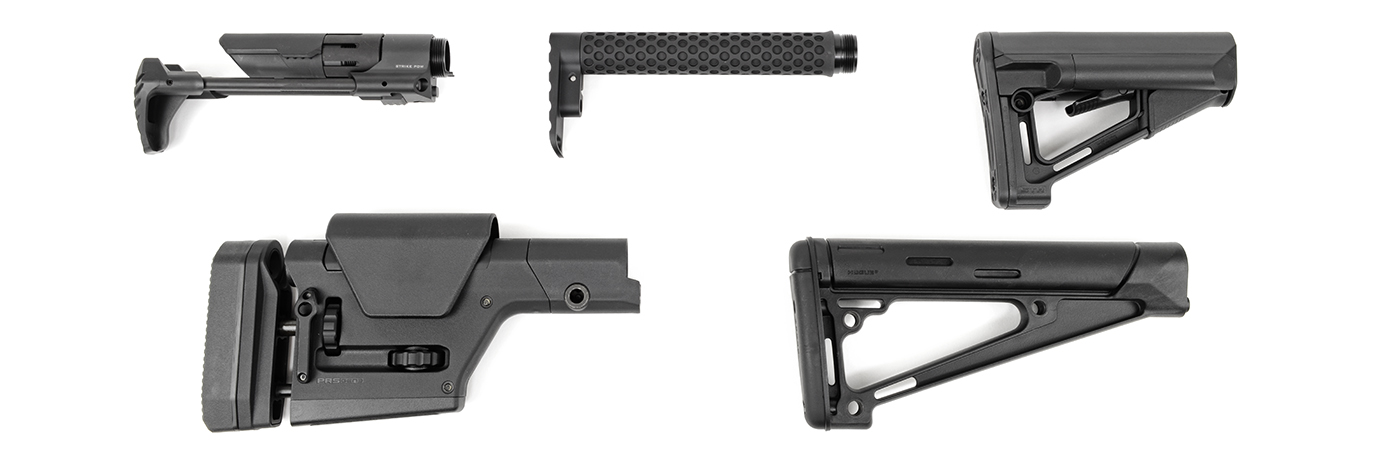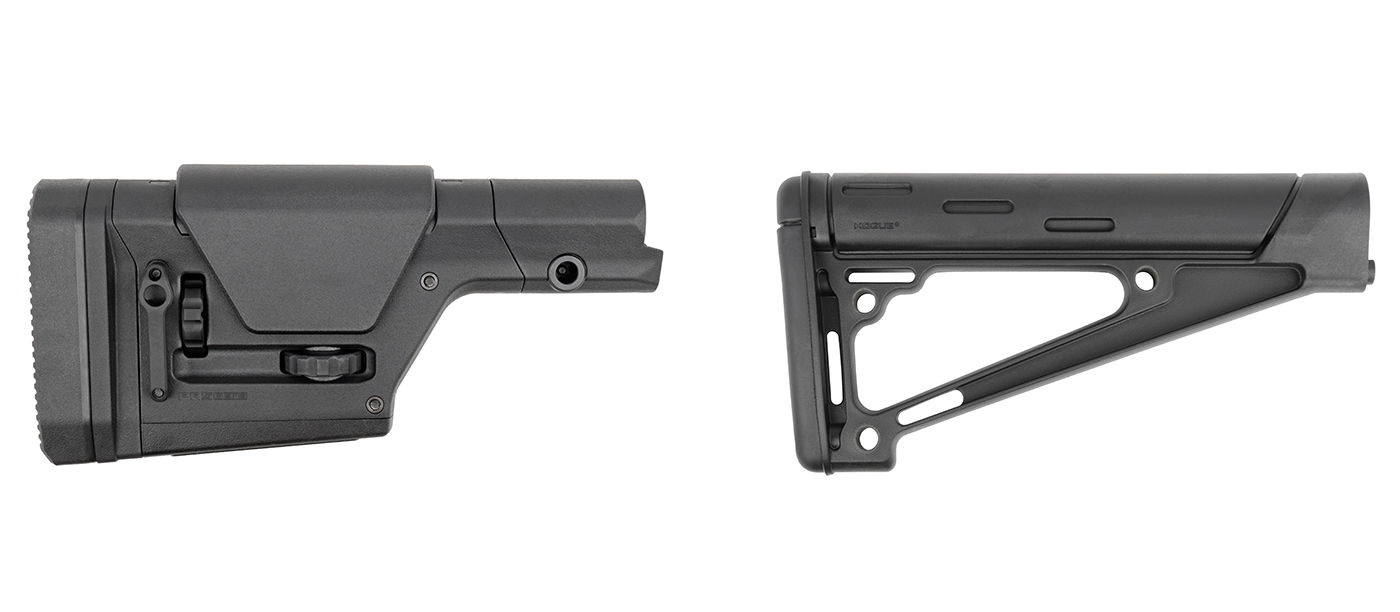
The stock is an integral part of any rifle. It directly impacts the effectiveness of a rifle and can make it more stable, accurate, and comfortable to shoot. When it comes to AR-15s, there are loads of options for stocks in the market. From fixed stocks to pistol braces, there are so many different options to choose from, so in this post, we are going to tell you how you can choose the right stock for your AR-15.
Purpose of The Rifle
Like any other part of the rifle, there isn't one type of stock that is ideal for every shooter. There are many different types of stocks available in every price range. To find out which one is best for your rifle, you need to consider the purpose of your rifle and what kind of parts will help you achieve that purpose more effectively and efficiently.
For instance, if you are using a rifle for long-range shooting, you'll want a full-size adjustable stock, with a cheek rest, butt pad, and perhaps a monopod as well. On the other hand, you'll probably want a light and simple stock if you want a fast and maneuverable rifle for CQB or competition shooting. If you are going to carry the rifle in a vehicle, you'll want a collapsible stock that doesn't add too much to the rifle's length. Some stocks even have angled butt pads, making them easier to shoulder when wearing body armor.
Therefore, to know what kind of stock to look for, you need to understand the primary purpose of your rifle and choose accordingly.
Types of Buffer Tubes

Another important thing to know is what type of buffer tube your rifle has. If you are building an AR, you should make sure that you use the right buffer tube for your preferable stock. There are three common types of buffer tubes used with AR-15s.
A2 Style Buffer Tube
A2 buffer tubes were used with the original A2 M16 rifles, which had fixed stocks. These buffer tubes are longer than modern Mil-Spec and commercial AR-15 buffer tubes, resulting in a lower cyclic rate and better shock absorption and recoil mitigation. However, they are 10-inches in overall length and protrude 9.5-inches behind the receiver. Therefore, they aren't the best for maneuverability and aren't used as commonly today. The external diameter of an A2-style buffer tube is about 1.115 inches.
Mil-Spec Carbine Buffer Tube
The Mil-Spec carbine buffer tube is the most common kind of buffer tube used with AR-15s, and M4s. Mil-Spec buffer tubes are machined from billet aluminum and have a one-piece design. The threads on the front of the tube are larger than the tube itself, and after they are rolled, the rest of the tube is machined down to achieve a one-piece design and has an eternal diameter according to military specifications. This is a more expensive manufacturing process as compared to commercial buffer tubes. However, it allows it to be more sturdy while having a smaller tube diameter. The external diameter of a Mil-Spec buffer tube is 1.148 inches. Most popular brands like LWRC International, LMT, HK, Colt, Smith & Wesson, Armalite, and many others use Mil-Spec buffer tubes. The length of carbine buffer tubes is 7.25 inches.
Commercial Carbine Buffer Tube
Commercial buffer tubes are made with a different manufacturing process and are made from two separate pieces. The manufacturers start with a tube that matches the final tube diameter and cut the threads on one end. The end cap is welded onto the tube. This design means the tube needs to have a thicker material to achieve the required rigidity. Therefore, commercial carbine buffer tubes are thicker and have an outer diameter of 1.168". These tubes aren't as popular as Mil-Spec buffer tubes, and some common brands that use them are Bushmaster, DPMS, and Rock River Arms
Types of Stocks
After you figure out what kind of buffer tube you will use, you can choose the right stock for your build. Generally, there are four main types of stock available for AR-15s on the market. You have fixed stocks, collapsible stocks, PDW stocks, and minimalist stocks. Here is a brief explanation of each kind.
Fixed Stocks

As the name suggests, Fixed stocks usually stay in place and have no wiggle or movement whatsoever. In some cases, higher-end fixed stocks offer limited adjustment, but most times, they have a solid build and no movement at all. For example, Mil-Spec M16 rifles initially issued to US troops had fixed stocks. Therefore, most fixed stocks on the market are designed to fit on A2 style buffer tubes. Still, you can find smaller fixed stocks for carbine buffer tubes as well.
These stocks are really good for long-range precision shooting because they feel the same every time and do not shift or move. Moreover, they are very sturdy and durable as well. However, they can be long and heavy sometimes. Furthermore, they can't be easily replaced, like other types of stock.
The Magpul PRS Precision Adjustable Stock is an excellent example of a high-end fixed stock ideal for precision shooting. It is fixed to the receiver but comes with an adjustable butt pad and many other features. The drawback of these features loaded stocks is their weight. They tend to be much heavier than a featureless fixed stock.
Collapsible Stocks

Collapsible stocks offer a much higher level of adjustability to the shooter. They are usually made to fit carbine buffer tubes and have multiple locking points so that you can set the length of pull according to your requirements.
This can be very beneficial for several reasons, it makes the rifle easier to use by different shooters. It also allows you to adjust the length of pull for ideal comfort when you are wearing body armor or simply carrying the rifle. Collapsible stocks are usually lightweight and offer a lot of adjustabilities while being more comfortable than minimalist stocks, PDW stocks, and pistol braces. This makes them ideal for any rifle, but perfect for competition shooters. The Magpul STR Stock is a good example of a collapsible stock.
Minimalist Stocks

As the name suggests, a minimalist stock is made to serve the bare-bones function of a stock. They aren't the most comfortable options out there, and they don't have cheek rests, rubber butt pads, or any extra amenities.
These simple and very lightweight stocks are designed to simply give the shooter a solid surface to shoulder the rifles. Most minimalist stocks aren't adjustable either and come with their own buffer tubes as well. The buffer tube and stock are made as one part to keep your rifle lightweight.
If you are going for a super lightweight AR build, a minimalist stock is the way to go. They are simply affordable and get the job done effectively. The Battle Arms SABERTUBE Buffer Tube and Lightweight Buttstock is an excellent example of minimalist buttstock systems.
PDW Stocks

If you want a compact rifle or perhaps a very short and concealable SBR, you should opt for a PDW stock. These stocks take "compact" to a whole new level and have stock rods that collapse on the sides of the lower receiver. This makes the rifles very short and ideal for CQB or transport.
These stocks usually come with very small buffer tubes and have their own buffers and springs. The shorter buffer tubes allow the stocks to collapse in a much smaller form. Even PDW style stocks offer a lot of benefits, they aren't ideal for completion or long-range rifles, but for a compact personal defense weapon, they are perfect.
Features That You Might Want
AR-15 stocks have many different features, and here are some that you should look for when buying one.
Sling Attachment Point
If you want to carry your rifle comfortably for a long time, it needs to have a sling. AR-15s don't have a sling attachment point on the receiver; therefore, they must be on the front handguard and the rear end of the rifle.
This is why most stocks have QD sling attachment points, and some have simple hoops for slings. Either way, when you are buying a stock, you should look for a sling attachment point.
Friction Lock
Most high-end AR-15 collapsible stocks have a friction lock system, which allows them to be adjusted, but limits excessive movement. This minimizes wobble and offers a much more stable platform for shouldering your rifle. Moreover, it prevents the stock from collapsing when you don't deliberately want it to.
Rubber Buttpad
Rubber butt pads are a staple feature of precision and high-end AR-15 stocks. When a rifle is fired, the recoil impulse stabs the relief stock into your shoulder, and though it won't feel that bad after a few shots, if you shoot for a long time, it can really start to hurt, to the point that you may start flinching on your shots and lose accuracy. Rubber butt pads offer a softer interface between your shoulder and the stock, allowing a more comfortable shooting experience.
Cheek Weld
If you are going to shoot your rifle for accuracy, having a stock that offers a good cheek weld is essential. This is why most precision stocks have a swollen cheek rest, which allows you to get multiple points of contact on the stock, with your shoulder and your cheek, for better stability, and sight acquisition.
Storage Compartment
Some stocks also have a storage compartment, which can store small items, like cleaning kits, extra batteries for your optics, and other essentials.
Conclusion
The stock is one of the essential parts of any rifle that plays a major role in determining its shooting experience and effectiveness. Though it can be challenging to navigate all the options available in the market, we hope this post helps you choose the ideal stock for your AR-15.